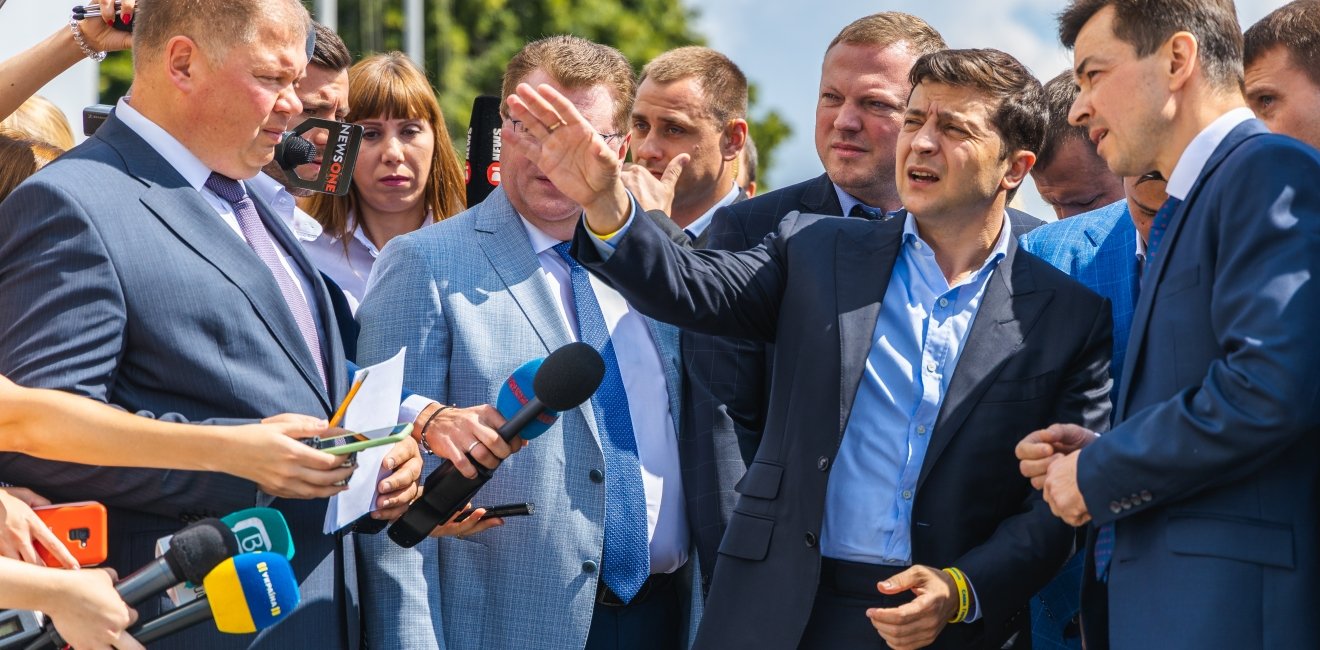
A blog of the Kennan Institute
BY MYKHAILO MINAKOV
Approximately two years ago, in April 2019, Volodymyr Zelensky came to power through a relative landslide in the second round of elections when 73 percent of Ukrainian voters selected him over his opponent, the incumbent Petr Poroshenko. On May 20, 2021, the presidential team put together a big press event at which President Zelensky was to report on his achievements as president and discuss his administration’s plans for the remaining three years of his tenure.
The team decided to hold the event in a hangar of the Antonov aircraft company, in front of a huge AN-225 “Mriya” (Dream) plane. Such a background was chosen to send an optimistic message to the nation and underline the president’s dream of a bright future for Ukraine. Instead, the disappointed journalists reported that the late Soviet era Mriya was without engines and the press event moderator took questions only from representatives of the media loyal to the president.
So the question about the results of President Zelensky’s first two years in office remained largely unanswered at the presser. I will try to provide an assessment here, continuing the logic of our previous assessments: by comparing the interim results with the promises Zelensky made as a candidate. In 2019 Zelensky’s victory mainly rode on three expectations of Ukraine's frustrated voters: (1) peace in the Donbas, (2) good governance and an end to corruption, and (3) the improved well-being of ordinary Ukrainians. How well has President Zelensky and his team met these expectations as the president approaches the midpoint of his first term?
The Situation in the Donbas and Russia-Ukraine Relations
As of early June 2021, the situation in the Donbas has become rather threatening. After a period of active talks between Kyiv, Moscow, Paris, and Berlin, as well as talks with the Russia-backed separatists operating in eastern Ukraine, the immediate risk to Ukraine posed by activities on the Donbas front line fell. In 2019–20 the conflicting sides conducted prisoner exchanges and pulled their armed forces out of three zones along the line of conflict. A July 2020 ceasefire was followed by a decrease in the number of victims, with attacks on either side being kept to a minimum. There were expectations that the ceasefire would evolve into a stable conflict resolution process.
The situation did not hold, however. In the winter of 2020–21 the situation on the front line worsened significantly. The Minsk process stalled, and meetings of the Trilateral Contact Group became less and less fruitful. According to the daily OSCE SMM reports, the number of victims on both sides now has returned to pre-July 2020 levels (fifteen to twenty-five killed each month on both sides of the front line). The number of attacks has doubled, and the number of shots fired during each attack has quadrupled since early February 2021. The rhetoric of Moscow and Kyiv has grown hostile, and military forces were moved closer to the Donbas and Crimea. Russian troops were also moved closer to the Ukrainian border in March–May 2021.
Today the talks are mired in disputes over how to implement the Minsk agreements. President Zelensky has been pushed into the same corner as his predecessor: no Ukrainian president can implement the Minsk agreements since the provisions of the agreements are not accepted by Ukrainian society. Yet this document is the only agreement that keeps Eastern Europe from returning to an active war situation.
There is a small silver lining to this difficult turn of events, and one that can be chalked up on the achievement side of the ledger. The looming risk of a more consequential Russia-Ukraine military conflict has returned the Ukraine issue to the front burner of international politics. President Biden made a long-delayed phone call to President Zelensky that launched engagement and cooperation between Kyiv and the new U.S. administration. Cooperation was deepened after a recent visit of U.S. secretary of state Antony Blinken to Kyiv. And Kyiv’s European partners have become more active after the meeting of President Zelensky and France’s President Macron.
In addition, President Zelensky’s administration has launched a Crimean Platform initiative, which has increased political pressure on Russia regarding the annexed Crimea. Western participation in Kyiv’s initiative is growing steadily: the first forum of the platform, scheduled for August 23, 2021, will be attended by the presidents of Latvia, Poland, and Slovakia, with representation from the United States and the EU.
The Good Governance and the Fight against Corruption
Zelensky’s team has constructed an informal “vertical” that is far from any good governance or rule of law principles. In this new power vertical, the major role belongs to the Office of the President, while the Verkhovna Rada and the Cabinet of Ministers have lost their Realpolitik authority. The security services and general prosecutor’s office proved unable to cooperate effectively to both fight corruption and promote the interests of the ruling group. As a result, since October 2020, the National Security Council, de jure an advisory organ, has become the center of the presidential team’s decision-making. This decision-making is conducted in the style of “emergency politics,” without the requisite respect for Ukraine’s constitution and the division of powers stipulated therein.
So far, this vertical of power has functioned effectively, endowing the president with the image of a strong leader defending his people against “corrupt judges” (especially the judges of the Constitutional Court) and pro-Russia politicians (mainly Viktor Medvedchuk and his allies). Unlike many presidents before him, Volodymyr Zelensky enjoys an astonishingly high level of trust nationwide: two years into his presidency, 46 percent of Ukrainians trust the sitting president (while 51 percent do not trust him). At the same period of his presidency, President Poroshenko enjoyed a trust rating of 20 percent (with 71 percent of respondents distrusting) and President Yanukovych had a trust rating of 22 percent (with 70 percent distrusting).
This is not the first power vertical to have emerged in Ukraine over the past thirty years: power verticals existed during the administrations of Presidents Kuchma, Yanukovych, and Poroshenko. But it is the first informal power structure that may be prepared to take on all the old guard Ukrainian oligarchs. The draft of an anti-oligarch law offers a radically different approach to this fight: it aims not to correct the root causes leading to the perpetual reemergence of the clans but at the assets and actions of the clan leaders themselves. It remains to be seen whether the draft law will survive scrutiny by the parliamentary committees without losing its teeth.
Outside the presidential vertical, the anti-corruption agencies and the Ministry of Interior have remained autonomous. The Western governments have managed to insist on the autonomy of the anti-corruption institutes created in the wave of reforms after the Euromaidan—at least until 2022, when the mandate of Artem Sytnyk, director of NABU, expires.
The Ministry of Interior has remained in the hands of the unchanging minister Arsen Avakov, who has served in succession Presidents Turchynov, Poroshenko, and Zelensky, though signs are emerging that Minister Avakov is finally losing his autonomy and authority.
Unlike his predecessors, President Zelensky personally has remained beyond suspicion in matters relating to corruption. Yet there is growing concern about the behavior of his entourage, especially in connection with the presidential flag project, Great Construction, which allocated a record amount from Ukraine’s national budget for infrastructure projects but appears to have become bogged down, dogged by charges of politicization and unrealistic goals.
The Well-being of Ukrainians
The issue of Ukrainians’ well-being has drawn critical attention in light of the COVID-19 pandemic. The socioeconomic situation for many Ukrainians is difficult indeed. Ukraine’s GDP dropped 4.2 percentage points in 2020, though it is expected to regain 4 percentage points in 2021. Unemployment is growing and prices are increasing, especially for communal services and housing, even as fewer households are eligible for subsidies. Ukraine has one of the lowest vaccination rates in Europe, which forced Zelensky’s team to install a new minister of health in May 2021. Household income and the health of family members remain among the key issues for Ukrainians.
Yet the socioeconomic grievances do not translate into lack of trust in the president. Instead, a growing number of Ukrainians view the future with optimism. According to a recent poll, from January 2021 (when Zelensky’s ratings reached their nadir) to May 2021, the share of optimists increased by nine percentage points, reaching 25 percent of those surveyed, while the share of skeptics dropped from 73 percent to 65 percent in the same period.
Moreover, President Zelensky is regarded by Ukrainians as the second best president the country has had in its thirty years of independence. Leonid Kuchma (presided 1994–2005) was regarded by 23 percent of those polled as the best president ever, while Volodymyr Zelensky was designated the best president by 18 percent. The subsequent rankings proceeded as follows: Petro Poroshenko (2014–19, 14 percent), Viktor Yanukovych (2010–14, 13 percent), Leonid Kravchuk (1991–94, 12 percent), and Viktor Yushchenko (2005–10, 7 percent).
Two years after entering the stormy waters of Ukrainian politics, Volodymyr Zelensky is a politically engaged leader who has managed to mobilize support from the citizenry despite unmet expectations and a deteriorating quality of governance. President Zelensky is good at keeping himself at a remove from the corruption scandals and at delivering a political show that helps retain the sympathies of a relative majority of voters. There is no political figure in today’s Ukraine who could challenge the president, and there is no political figure or force that could undermine the newly constructed power vertical. If the Zelensky team ever fails, it will be of its own doing.
The opinions expressed in this article are those solely of the authors and do not reflect the views of the Kennan Institute.
Author


Kennan Institute
After more than 50 years as a vital part of the Wilson Center legacy, the Kennan Institute has become an independent think tank. You can find the current website for the Kennan Institute at kennaninstitute.org. Please look for future announcements about partnership activities between the Wilson Center and the Kennan Institute at Wilson Center Press Room. The Kennan Institute is the premier US center for advanced research on Eurasia and the oldest and largest regional program at the Woodrow Wilson International Center for Scholars. The Kennan Institute is committed to improving American understanding of Russia, Ukraine, Central Asia, the South Caucasus, and the surrounding region through research and exchange. Read more

Explore More in Focus Ukraine
Browse Focus Ukraine
Talking to the Dead to Heal the Living

Ukrainian Issue in Polish Elections


